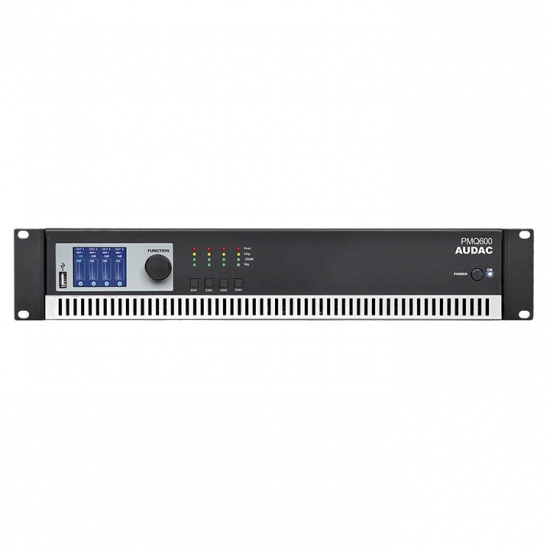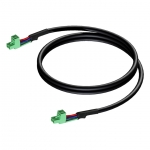Are you sure you want to perform this action?
PMQ600 WaveDynamics™ quad-channel 70/100V power amplifier
WaveDynamics™ quad-channel 70/100V power amplifier
The PMQ series are professional 70/100V quad-channel power amplifiers, providing a new standard for premium sound 70/100V amplification in public address applications. Their advanced features and availability in different output powers provide an enormous flexibility for numerous applications.
The PMQ600 is a four-channel Class-D 70/100V power amplifier with an output power of 600 Watt for each channel. The WaveDynamics™ DSP processor combination with the 2.5” LCD display gives an unmatched user experience with intuitive functions overview for easy configuration.
Acoustics can be optimized using the filters selectable between Low / High & Band Pass and the 7-Band equalizer both with adjustable frequencies and Q-factor. Other provided functions are delay and dynamic bass boost. These settings can be custom configured using the front panel of the amplifier, whereby access can be given on two different levels (User & Administrator) using password or USB-key protection.
Configuration is made simple by the loudspeaker presets and full system configurations which can be selected from a library and uploaded with a USB flash drive. This ensures the best acoustical performance with a ‘bullet-proof’ loudspeaker protection.
A great input flexibility and source compatibility is offered by the input selection matrix and the XLR and terminal block signal connections. System integration is made easy using the RS-232 control port. Optional Dante™ interface is available for the WaveDynamics™ amplifiers. The installation of this network interface allows receiving and sending of low latency, high-quality audio over a standard Ethernet network.
- Terminal block output connections
- RS232 control
- Dante expansion port
- XLR input & link through connections
- Lightweight Class-D amplifier
- Advanced DSP and loudspeaker management
- 2.5" LCD display with an intuitive user interface
- WaveDynamics™ speaker & set configurations
| RMS Power : | 4 x 600 W |
| Frequency Response (± 3 dB) : | 50 Hz - 20 kHz |
| Signal / Noise : | < 0.05 dB |
| Crosstalk (@ 1 kHz) : | > 70 dB |
| Technology : | Class-D |
| Power Supply : | Switching mode |
| Power Supply Operating : | 230 ~ 240 V AC / 50 ~ 60 Hz |
| Inputs Sensitivity (1W/1m) : | -30 dB ~ +5 dB |
| Inputs Impedance : | 10 kΩ balanced |
| Common mode rejection ratio : | 70 dB |
| Damping factor : | > 200 |
| Protection Amplifier : | DC Short circuit |
| Protection Amplifier : | Over heating |
| Protection Amplifier : | Over load |
| Protection Amplifier : | Signal limiting |
| Protection Access : | User & Administrator level (Through password and USB-key protection) |
| Cooling : | Temperature controlled FAN |
| Operating temperature : | 0° ~ 40° @ 95% Humidity |
| Inputs Connector : | XLR & 3-pin Euro Terminal Block (3.81 mm) |
| Outputs Connector : | 4-pin Euro Terminal Block (Pitch - 5.08 mm) |
| Dimensions : | 482 x 88 x 420 mm (W x H x D) |
| Weight : | 8.6 kg |
| Mounting : | 19” |
| Unit height : | 2 HE |
| Construction : | Steel |
| Colours : | Black |
Total control of your audio system
WaveDynamics™ is an audio control and processing technology implemented in AUDAC amplifiers. Thanks to the powerful DSP processor that is built into the amplifiers it can deliver effortless control over the most advanced acoustic configurations.
A complete library of AUDAC loudspeaker and set solution presets is available for your projects, making it easy as picking the right file, loading it & play! Besides the optimal acoustic configurations, this library also includes the loudspeaker performance parameters providing bulletproof protection for them.

CONTROLLABILITY
The operation and configuration of WaveDynamics™ can be done in multiple ways. The most obvious way is by using the front panel controls, featuring a Scroll-Push control™ and channel selection buttons with a clear and intuitive user interface on the 2.5” graphical LCD display.
The integration of the audio system into the home and industrial automation systems is made easy through the RS232 connection & control port whereby functions such as input switching, volume adjustment, etc. can be controlled.
FLEXIBILITY
Each of the input connections can be patched to any amplifier channel and contains software controllable gain. The different implementations of the in- and output connectors allow the easiest way of connection for every application while allowing signal link through to other amplifiers.
PROTECTION
Optimal protection is not only required for the listener’s satisfaction but can also be important for complying with the imposed regulations and guaranteeing the lifetime of the equipment. Because of this, protection precautions are implemented in different ways.
Firstly, user access is made possible on different levels. The device can be blocked or accessed at the user or administrator level. Different levels allow different configuration and control functions, giving limited (Eg: only volume) control access to standard users and full configuration control to administrators. User restriction can be enabled and disabled and is given through a password and/or USB key.
Secondly, equipment protection is implemented by an output limiter which monitors the output power of every channel and will intervene when the output exceeds a certain level. The corresponding level can be software configured and is indicated in Watts. When the output limiter is configured at the maximum power of the loudspeaker, you can rest assured that the loudspeakers won’t be blown during your absence.
Lastly, the maximum volume for every channel can be set independently. This prevents users (having volume access) from going over the limit. This can help you to keep the system compliant with imposed regulations and maintain a good relationship with the neighbors.
EFFICIENCY
The switching mode power supply and Class-D amplifier technology in combination with the auto-standby mode for each separate amplifier channel bring an end to the era of the power-hungry amplifiers. In addition, these features also result in a lightweight amplifier that benefits the customer when used in mobile applications.
| Download all WaveDynamics™ speaker presets |
An easy and logical way of controlling volume and more advanced settings
This extremely efficient way of controlling your user interface is incorporated in AUDAC wall panels, WaveDynamics™ amplifiers, audio players, and MTX matrixes. It allows an easy and logical way of controlling volume and more advanced settings such as EQ and source selection. The Scroll-Push™ button also provides a design advantage to the front of the device by replacing a large selection of buttons.
Decentralize your audio solutions
TouchLink™ is an ingenious system that can be used for creating virtual zones by linking multiple compatible devices with each other. In AUDAC Touch™ 2 or directly on the device you can select multiple amplifier channels that should react to the user as one zone.
Main functionalities:
- Setting up (virtual) zones by grouping devices.
- Share input, volume & mute settings across these devices.
- Priority settings.
Setting up (virtual) zones
So how does it work? In AUDAC Touch™ 2 or directly on the device you can select up multiple compatible devices or outputs that should react to the user as one zone by assigning it the same TouchLink™ zone ID (e.g. 1, 2, 3, ...). All devices with the identical TouchLink™ ID will virtually work as one zone. Compatible devices are the AMP203, which has network functionality built in by default but also the following devices when equipped with the ANI44XT Network interface:
- MFA series
- SMA series
- SMQ series
- PMQ series
- VEXO series
- And more to come
Share input, volume & mute settings
In these virtual zones, you can share the inputs, volume & mute settings between the different devices so that they actually act as one (physical) zone. To counteract the possible differences in amplifier power, you can set volume offsets for each unit. This will set a constant difference in volume that will be maintained even if the overall volume of the zone is changed.
As mentioned, all inputs can be shared with the devices in the Touchlink™ zone. Keep in mind that it is important that the input lists are the same: On all the devices you will have to map the same inputs but of course, it is possible that local input 1 on one device is the same as Dante 1 on another device. Additionally, a wall panel that is physically connected to one of the linked devices will automatically control all the linked devices.
Priority settings
Last but not least, you can also send priority messages with the MFA to these zones. The priority settings are shared among the different devices within the zones and can be triggered via the SourceCon™ module, Mic input, or Line in. When a priority is activated, the current input stops playing and the priority message starts playing on all the different devices. Additionally, you can set a different volume and/or offset of all the devices to ensure good intelligibility.
Different priority profiles can be set up that can also have priority over each other.
PRODUCT
-
HOW IS THE POWER CONSUMPTION OF AMPLIFIERS TESTED & INDICATED?
As the power consumption of an amplifier, strongly depends on how hard the amplifier is driven, measurements are provided for various loads: idle, 1/8 of average full power, 1/3 of average full power, and full power.
Idle
Current draw at idle or with very low signal level1/8 Power: Pink Noise
Amplifiers are tested using pink noise signals to simulate real-world speech and music signals. It approximates operating with music or voice with light clipping and represents the amplifier's typical "clean" maximum level, without audible clipping. This 1/8 power signal provides a very good approximation of how hard an amplifier would be driven by typical real-world speech/music signals, assuming those signals were being driven as loud as possible without clipping the amplifier.1/3 Power: Pink Noise
1/3 Power Pink Noise is similar to 1/8 Power Pink Noise, except that it is a significantly more powerful input signal. It approximates operating with music or voice with very heavy clipping and a very compressed dynamic range. This 1/3 power signal provides an approximation of how hard an amplifier would be driven by typical real-world speech/music signals, assuming those signals were being driven loud enough to clip the amplifier heavily, and produce severe, audible distortion.Full Power
Current draw at full power is measured with a sine wave at its maximum possible level. However, it does not represent any real-world operating condition and represents the absolute extremes that an amplifier could ever experience.
*Note: AUDAC operates a policy of continuous development. AUDAC reserves the right to make changes and improvements to any of the products described on this website without prior notice. Specifications are subject to change without notice. Please refer to the manufacturer's web page for the most up-to-date specifications and product details www.audac.eu For the most up-to-date Software and Firmware visit www.audac.eu.







